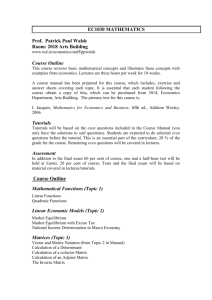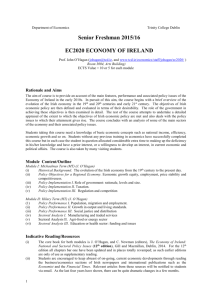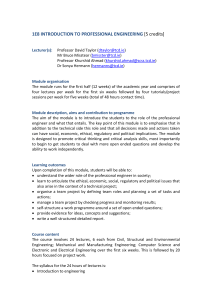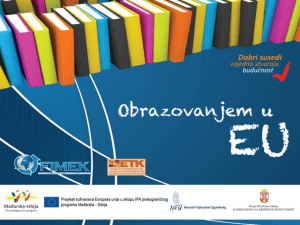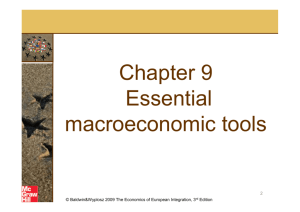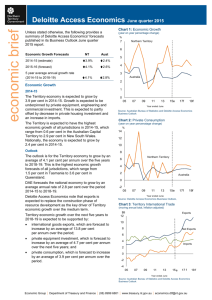A2 EC3030 Course Outline
advertisement
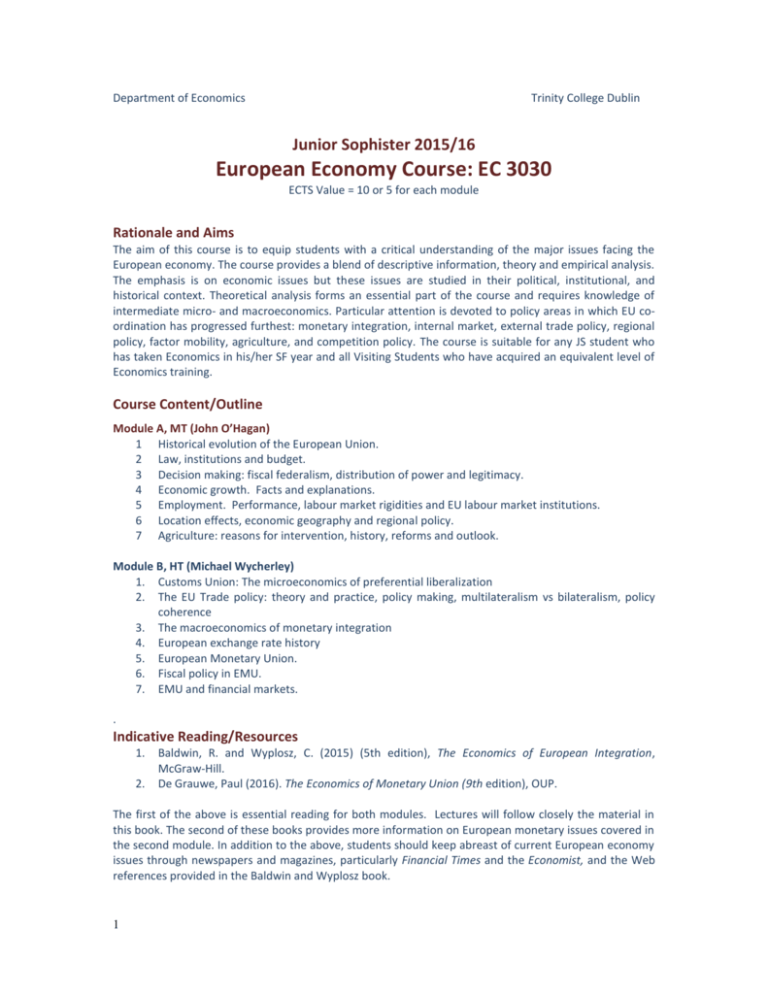
Department of Economics Trinity College Dublin Junior Sophister 2015/16 European Economy Course: EC 3030 ECTS Value = 10 or 5 for each module Rationale and Aims The aim of this course is to equip students with a critical understanding of the major issues facing the European economy. The course provides a blend of descriptive information, theory and empirical analysis. The emphasis is on economic issues but these issues are studied in their political, institutional, and historical context. Theoretical analysis forms an essential part of the course and requires knowledge of intermediate micro- and macroeconomics. Particular attention is devoted to policy areas in which EU coordination has progressed furthest: monetary integration, internal market, external trade policy, regional policy, factor mobility, agriculture, and competition policy. The course is suitable for any JS student who has taken Economics in his/her SF year and all Visiting Students who have acquired an equivalent level of Economics training. Course Content/Outline Module A, MT (John O’Hagan) 1 Historical evolution of the European Union. 2 Law, institutions and budget. 3 Decision making: fiscal federalism, distribution of power and legitimacy. 4 Economic growth. Facts and explanations. 5 Employment. Performance, labour market rigidities and EU labour market institutions. 6 Location effects, economic geography and regional policy. 7 Agriculture: reasons for intervention, history, reforms and outlook. Module B, HT (Michael Wycherley) 1. Customs Union: The microeconomics of preferential liberalization 2. The EU Trade policy: theory and practice, policy making, multilateralism vs bilateralism, policy coherence 3. The macroeconomics of monetary integration 4. European exchange rate history 5. European Monetary Union. 6. Fiscal policy in EMU. 7. EMU and financial markets. . Indicative Reading/Resources 1. 2. Baldwin, R. and Wyplosz, C. (2015) (5th edition), The Economics of European Integration, McGraw-Hill. De Grauwe, Paul (2016). The Economics of Monetary Union (9th edition), OUP. The first of the above is essential reading for both modules. Lectures will follow closely the material in this book. The second of these books provides more information on European monetary issues covered in the second module. In addition to the above, students should keep abreast of current European economy issues through newspapers and magazines, particularly Financial Times and the Economist, and the Web references provided in the Baldwin and Wyplosz book. 1 Learning Outcomes On successful completion of this course, student should be able to: Review and summarise relevant reading material on various key aspects of European economic integration (see Course Outline above) Explain the importance and relevance of the information contained in this reading Understand the application of some basic economic theory and diagrams to issues of European economic policy Compare and contrast, using this theoretical economics framework, different aspects of the policy debate surrounding European economic integration Formulate a balanced, critical judgment on the status of each of these debates. Contact Hours/Methods of Teaching and Student Learning The main mode of teaching is the use of standard lectures, running for 50 minutes twice a week, throughout both semesters. The lectures will be used primarily to stimulate interest in the subject, provide introductions to some of the more difficult material in the core textbook, and to supplement the book where relevant. While the numbers taking the course can exceed 75, questions are welcomed, at least to a limited extent, during lectures. No lecture notes are produced for Module A, just bullet points to provide a context and focus for students during lectures. The slides for these (not more than three per lecture) will be placed on the dedicated web site for the course so that students can if they wish print them out in advance of the lectures and use the headings to structure their notes. Attendance at lectures is vital if you wish to get a good grade, for two reasons. First, much material covered in lectures is not in the book or on the slides. Second, there is no substitute for a ‘live’ lecture, either before or after reading the relevant book material. There will also be a class programme (details to be provided later) at which students will be asked to contribute to class discussion. Both lecturers will also be readily contactable by email to answer queries in relation to the course and to make face-to-face appointments if required. Students will be asked to evaluate the course and any overall suggestions for improvement taken on board where possible. Methods of Assessment 10 per cent for short test Week 8, MT 10 per cent for essay due first week HT (details to follow later) For students taking only Module A, they will have to do the first assignment, plus two essays for the second assignment (details to be provided later). Each assignment will carry 50 per cent of the marks. 15 per cent for an essay assignment due in Week 8 HT 65 per cent for the Summer examination, with two parts relating to modules. For students taking only Module B, the breakdown will be 30 per cent for the assignment and 70 per cent for the end of course exam (on which they will only have to do questions pertaining to Module B). Lecturers John O'Hagan, Room 3004, Department of Economics Email: johagan@tcd.ie, Web site for module A: www.tcd.ie/economics/staff/johagan/ec3030/; available also via Blackboard Michael Wycherley, Room 3007, Department of Economics Email: wycherlm@tcd.ie. Website https://sites.google.com/site/wycherlm/ec3030 available via Blackboard 2
